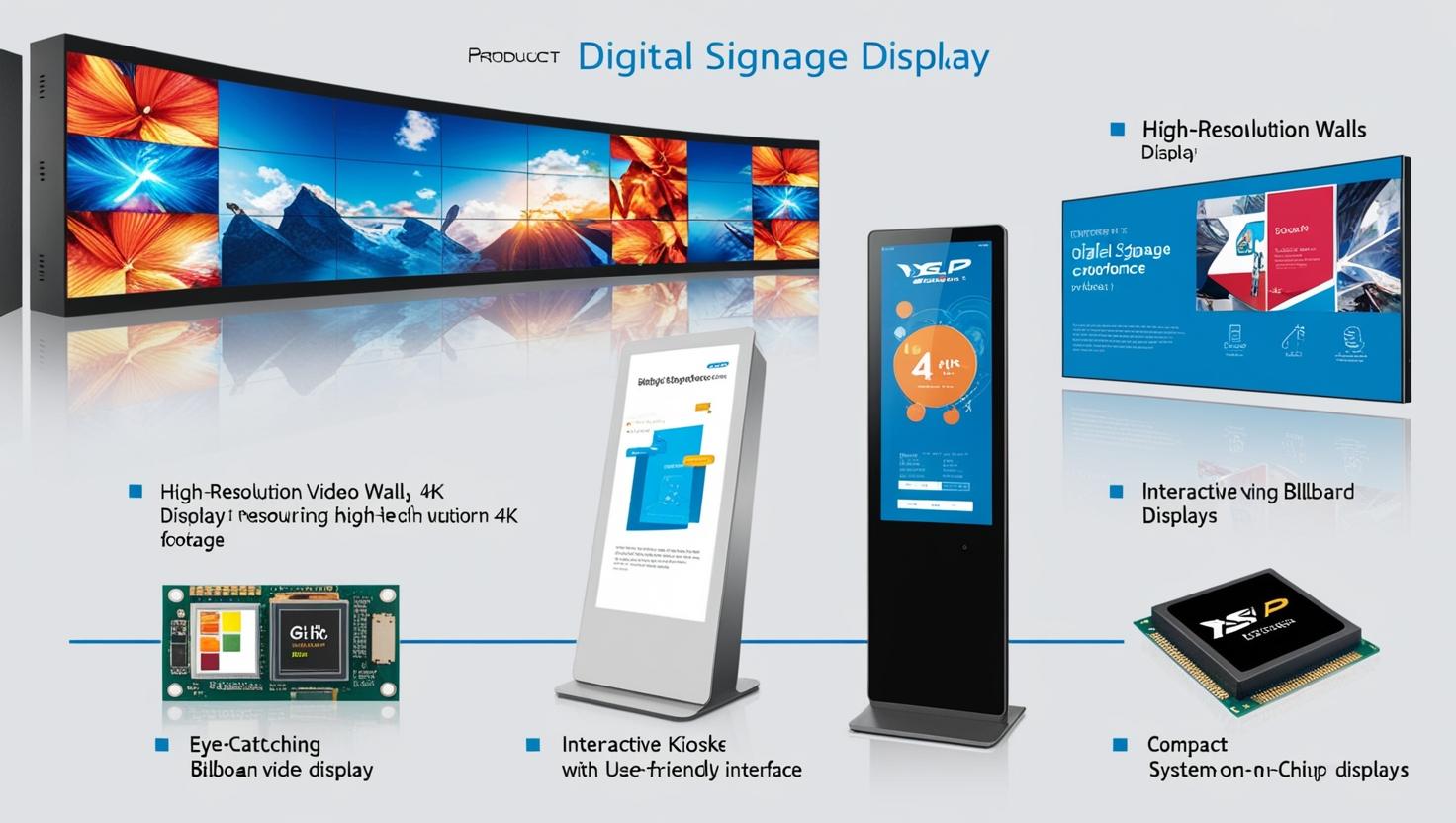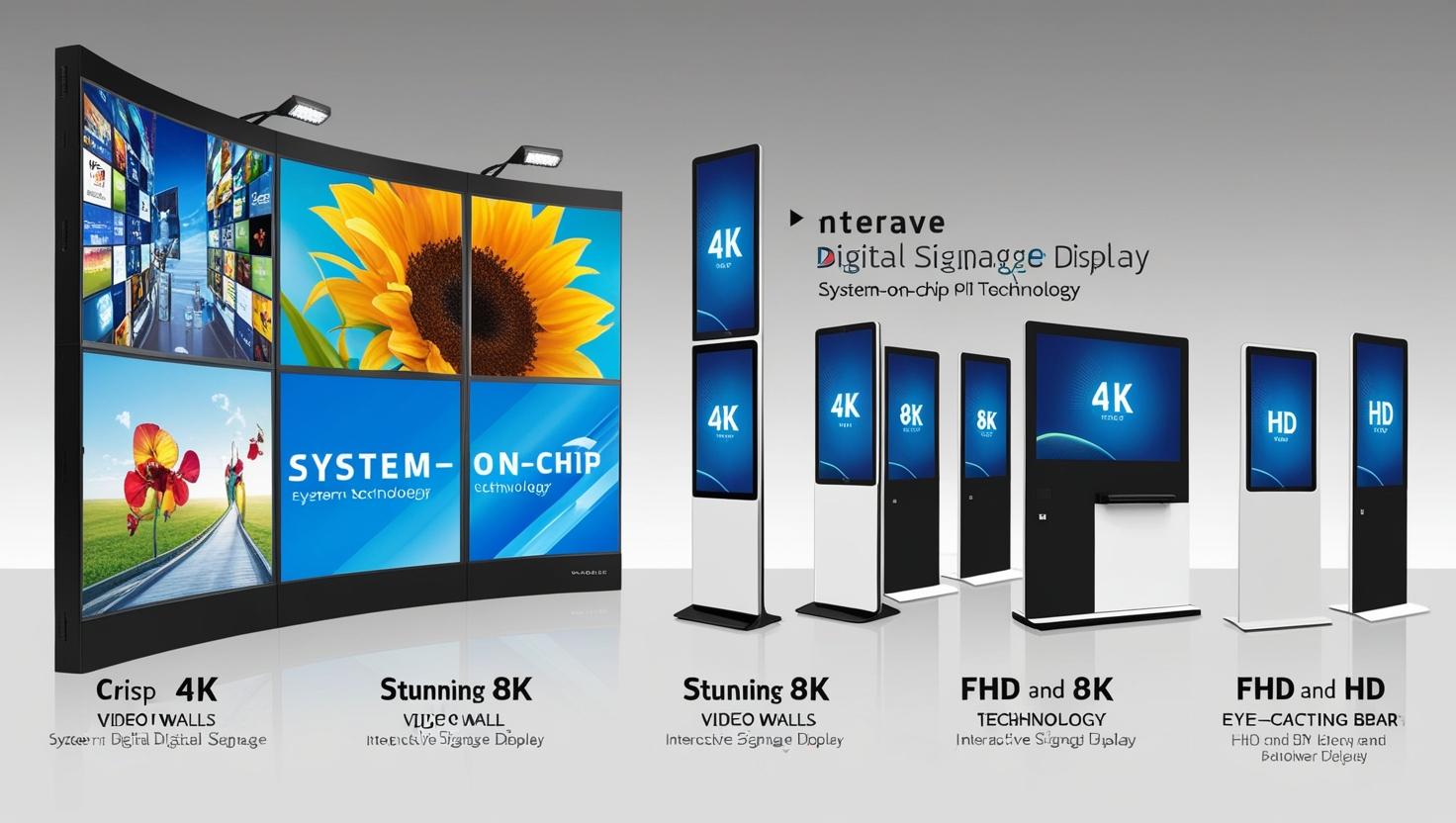In today’s fast-paced, technology-driven world, the digital signage market is evolving rapidly, becoming an indispensable tool for interactive advertising and communication. Businesses, organizations, and industries across the globe are leveraging the power of digital displays to enhance consumer experiences, increase engagement, and communicate in real-time. With advancements in technology, such as Artificial Intelligence (AI), the Internet of Things (IoT), and cloud-based solutions, digital signage is transforming the way brands communicate and engage with their target audiences.
As the digital signage market grows, it is essential to understand the latest trends shaping the future of interactive advertising and communication. In this article, we will explore these trends, their potential impact, and the opportunities they present for businesses to revolutionize their marketing strategies.
The Rise of Interactive Displays
Traditional static signage is giving way to dynamic and interactive digital displays that engage customers in real-time. With the use of touchscreens, motion sensors, and facial recognition, interactive digital signage enables customers to engage directly with the content.
Interactive digital signage allows customers to explore products, receive personalized recommendations, and even complete transactions—all from the same display. This level of engagement fosters a more immersive experience that enhances customer satisfaction and improves the chances of conversions.
From retail stores offering self-checkout to interactive kiosks in shopping malls, the demand for interactive digital signage is on the rise, especially in sectors like retail, hospitality, and transportation.

AI and Data Analytics in Digital Signage
Artificial Intelligence (AI) is playing a crucial role in revolutionizing the digital signage industry. By integrating AI-powered software, digital signage systems can adapt content based on real-time data, improving the relevance and effectiveness of messages displayed.
AI allows digital signage systems to analyze consumer behavior, track interactions, and tailor content to the preferences of the target audience. For instance, AI-powered digital signage systems can detect the age, gender, and mood of individuals and display personalized content based on these attributes. This level of precision enables more relevant advertising, which results in better consumer engagement and higher conversion rates.
Moreover, the integration of data analytics helps businesses measure the performance of digital signage campaigns, identify patterns in customer behavior, and optimize content strategies for better results.
Cloud-Based Digital Signage Solutions
The transition to cloud-based digital signage solutions is one of the most significant trends shaping the industry. Cloud technology allows businesses to remotely manage and update digital signage content across multiple locations in real-time, eliminating the need for on-site maintenance and reducing operational costs.
Cloud-based systems also allow for easy scalability, as businesses can expand their signage networks without the need for complex hardware installations. By storing content in the cloud, businesses can streamline content management, ensure consistency across all displays, and push updates instantly, making it an essential solution for businesses with multiple locations or franchises.
Global digital signage industry
The global digital signage industry is projected to grow from USD 20.1 Billion in 2024 to USD 27.3 billion by 2029, registering a CAGR of 6.3% during the forecast period. The growth of the market can be attributed to the increasing adoption of digital signage in commercial applications such as retail & hospitality, surging demand for high resolution displays such as 4K & 8K displays, rising infrastructural developments in developing countries, and ongoing technological advancements in display sector.
Download PDF Brochure @ https://www.marketsandmarkets.com/pdfdownloadNew.asp?id=513
Seamless Integration with IoT Devices
As the IoT ecosystem continues to grow, digital signage is becoming increasingly interconnected with other smart devices. IoT-enabled digital signage can collect real-time data from a variety of sources, including sensors, cameras, and other devices, to deliver tailored content based on environmental conditions or customer behaviors.
For example, digital signage displays in retail stores can interact with customers’ smartphones through Bluetooth or Wi-Fi, offering personalized promotions or coupons based on the customer’s shopping history or location within the store. This seamless integration of IoT and digital signage is enhancing the customer experience by offering context-aware, personalized communication.
Sustainability and Energy Efficiency
Sustainability is becoming an increasingly important consideration for businesses in every sector, and the digital signage market is no exception. In response to the growing demand for environmentally friendly solutions, manufacturers are designing energy-efficient digital signage displays that consume less power while delivering high-quality content.
LED displays, for example, are becoming the standard in the digital signage industry due to their low power consumption, long lifespan, and vibrant visuals. Additionally, smart energy management systems integrated with digital signage allow businesses to schedule content delivery to optimize energy usage, contributing to a more sustainable approach to advertising.
As sustainability becomes a key concern for both consumers and businesses, the demand for energy-efficient digital signage solutions will continue to rise.
Augmented Reality (AR) and Virtual Reality (VR) Integration
The integration of Augmented Reality (AR) and Virtual Reality (VR) with digital signage is another trend that is transforming the industry. By combining immersive technologies like AR and VR with digital signage, brands can create more engaging and interactive experiences for their customers.
AR and VR-powered digital signage can allow customers to try products virtually, experience virtual store tours, or interact with advertisements in a more personalized way. For example, a customer could use an AR-enabled digital display to visualize how a piece of furniture would look in their home environment or view detailed product information in 3D. These immersive experiences create a lasting impact and encourage deeper engagement with the brand.
The use of AR and VR in digital signage is gaining traction in industries like retail, entertainment, and education, where creating memorable and engaging experiences is key to building customer loyalty.

Digital Signage in Transportation and Public Spaces
The transportation sector and public spaces are increasingly adopting digital signage to improve communication, provide real-time information, and enhance the passenger experience. In airports, train stations, and bus terminals, digital signage displays provide travelers with real-time updates on flight or train schedules, gate changes, and other important information.
Public spaces, including malls, stadiums, and government buildings, are also leveraging digital signage to improve crowd management, deliver targeted messaging, and promote safety. For example, digital signage can provide emergency alerts, wayfinding instructions, and event promotions, making it an essential tool in managing large crowds and ensuring smooth operations in public spaces.
Increased Focus on Personalization
Personalized advertising is one of the primary drivers of digital signage growth. With the help of advanced analytics, AI, and IoT, digital signage displays can deliver highly targeted content based on customer preferences, behaviors, and demographics.
Personalized content not only enhances customer engagement but also improves the effectiveness of advertising campaigns. Retailers can display tailored promotions and discounts, while businesses in the hospitality industry can provide location-based offers to customers in real time.
As consumer expectations evolve, businesses will increasingly adopt personalized digital signage solutions to create unique, customer-centric experiences that drive brand loyalty and sales.
5G and Its Impact on Digital Signage
The rollout of 5G technology is expected to have a profound impact on the digital signage market. With faster data transfer speeds, lower latency, and improved network reliability, 5G will enable digital signage displays to deliver high-quality content in real-time without the risk of lag or connectivity issues.
5G will also facilitate the growth of remote management, interactive content delivery, and AI-powered experiences, making it easier for businesses to manage their digital signage networks and deliver seamless, immersive content to customers.
The digital signage industry is undergoing a transformation, driven by the increasing demand for interactive, personalized, and data-driven experiences. From AI-powered systems and IoT integration to AR/VR applications and cloud-based solutions, the innovations in digital signage technology are paving the way for a new era of advertising and communication.
As businesses seek to engage customers in more meaningful ways, digital signage will continue to evolve, offering endless possibilities for creating immersive, real-time, and personalized experiences. By staying ahead of these trends, companies can leverage digital signage to not only drive customer engagement but also enhance their brand presence and improve their bottom line.
The future of digital signage is bright, with advancements in technology and changing consumer expectations shaping a new wave of interactive communication. As we move forward, the market will continue to expand, offering exciting opportunities for businesses to connect with their audiences in innovative and impactful ways.
FAQ: Digital Signage Market Trends
1. What is digital signage? Digital signage refers to the use of digital displays, such as LCD, LED, or projection screens, to show content such as advertisements, information, and media in public or private spaces. These displays are typically powered by software that allows real-time updates, interactivity, and content management.
2. How is digital signage different from traditional signage? Unlike traditional static signage, digital signage allows businesses to display dynamic, interactive content that can be updated remotely and in real-time. This provides greater flexibility, customization, and engagement opportunities for businesses to communicate with their audiences.
3. What are the key trends driving the digital signage market? Some of the key trends in the digital signage market include:
- The rise of interactive displays and kiosks
- Integration of Artificial Intelligence (AI) for personalized content
- The shift towards cloud-based solutions for easier management and scalability
- The use of Augmented Reality (AR) and Virtual Reality (VR) to enhance customer experiences
- Increasing demand for energy-efficient and sustainable displays
- The use of IoT to enable real-time data-driven content
- Growth in the transportation and public spaces sectors
4. How does AI impact digital signage? AI enhances digital signage by enabling content to be personalized based on real-time data, such as demographic information, customer behavior, and preferences. AI also helps optimize content placement, analyze interactions, and deliver more targeted and relevant messaging, thereby increasing engagement and improving conversion rates.
5. What industries are adopting digital signage? Digital signage is being widely adopted across various industries, including:
- Retail: For in-store promotions, product information, and personalized ads
- Hospitality: For digital menus, interactive directories, and guest engagement
- Transportation: For real-time information displays in airports, train stations, and bus terminals
- Healthcare: For patient and visitor information and communication in hospitals
- Corporate: For internal communication, employee engagement, and meeting room management
- Education: For announcements, event promotions, and interactive learning experiences
6. How does digital signage improve customer engagement? Digital signage helps businesses engage customers by providing dynamic, interactive content that catches attention. With the ability to offer personalized promotions, real-time information, and engaging visuals, digital signage keeps audiences informed and entertained, leading to higher customer satisfaction and improved brand loyalty.
